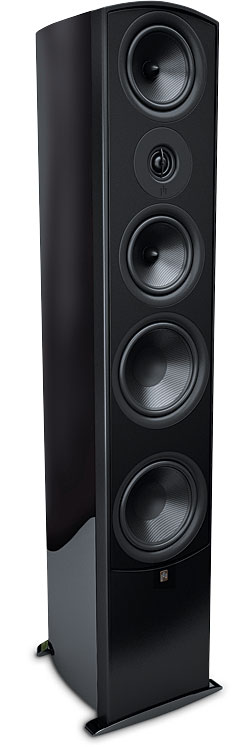Aperion Verus Grand Speaker System Page 2
 All of the main speakers have cloth-covered metal grilles held in place by magnets. They are hard to remove. Aperion provides a special removal tool, but it didn’t work on our samples. The space between the grille and the front panel frame was too tight. I managed to free the grilles by punching a sharp-edged pick with a right angle bend in it (similar to the pointy tool that dental assistants use as a torture device) through the grille cloth and the holes in the metal frame under it, then pulling outward. But unless you’re careful, this technique can damage the grille cloth. And be sure to choose a location about an inch from the edge to avoid damaging a drive unit (the outside inch of the steel frame has no perforations). A strong magnet might also grab hold sufficiently to pull the grille off, but I didn’t have one powerful enough for the job. This wouldn’t be an issue if the grilles didn’t affect the sound, but like every grille we’ve ever used, they do.
All of the main speakers have cloth-covered metal grilles held in place by magnets. They are hard to remove. Aperion provides a special removal tool, but it didn’t work on our samples. The space between the grille and the front panel frame was too tight. I managed to free the grilles by punching a sharp-edged pick with a right angle bend in it (similar to the pointy tool that dental assistants use as a torture device) through the grille cloth and the holes in the metal frame under it, then pulling outward. But unless you’re careful, this technique can damage the grille cloth. And be sure to choose a location about an inch from the edge to avoid damaging a drive unit (the outside inch of the steel frame has no perforations). A strong magnet might also grab hold sufficiently to pull the grille off, but I didn’t have one powerful enough for the job. This wouldn’t be an issue if the grilles didn’t affect the sound, but like every grille we’ve ever used, they do.
Aperion provides two curved rubber feet with the Verus Grand Center. If you use them between the speaker and its stand or support, you can tilt the speaker up or down, depending on whether it’s positioned above or below the screen.
One problem with the Verus Grand Tower’s narrow cabinet is that it isn’t highly stable, particularly on a carpeted floor. Spiking would help, but the spikes that Aperion provides are a bit too wide and dull to punch through most carpets. But there is an aftermarket solution. A company called Soundocity (soundocity.com) offers Spike Bars—outriggers—that not only stabilize a tall, narrow speaker but also have top-mounted adjustments that make leveling easier (see photo). They are not only functional but also add to the Verus’ high-end looks.
Verus Maximus 5.1
As noted above, the matching Bravus II 12D subwoofer we received as Aperion’s chosen mate for this system was being replaced by the Bravus IIa. Rather than review the system with a soon to be extinct subwoofer, I did my serious listening to the Aperions with a Hsu Research VTF-15H handling the subwoofing duties. The Hsu, which will rattle anything that’s loose in the room, is also a direct-sale product. It’s priced about the same as either the Bravus II or Bravus IIa, but it’s much larger and (at 123 pounds) much heavier. Hsu offers a similar 30-day trial, but the buyer pays return shipping, if needed.
As is my normal practice, I set up the Verus Grand Towers about 5 feet out from the short wall behind them in my 15.5-by-27-by-8-foot home theater studio. I positioned the left and right speakers about 9.5 feet apart, with the left speaker about 4 feet from the left wall and the right speaker about 2 feet from the right wall. This was further apart than I normally prefer, but it was necessary to accommodate a 101-inch-wide Elite screen then also under evaluation (see the review on page 48). I located the Verus Grand Center on a low stand under the screen and the Verus Grand Bookshelves near the back of the room, about 3 feet off the floor. The main seating position was about 11 feet from the front speakers and 7 feet from the surrounds.
A Parasound Halo A51 power amp and an Integra DTC-9.8 surround processor drove the speakers. The primary sources were Blu-ray players from Panasonic (the DMP-BDT350, used with an HDMI connection to the Integra processor for movie playback) and Pioneer (the Elite BDP-09FD, used as the primary CD transport with a digital coaxial connection to the Integra). Audio cables included vintage designs from Monster Cable, Cardas, and Kimber. All of the bass below 80 hertz, including the main left and right Verus Grand Towers, was directed to the Hsu subwoofer except where noted. The speaker grilles were removed for most of my listening. With the grilles in place, there was a small but noticeable loss of clarity, resulting in a more homogenized sound overall.
For movies, I prefer to sit about 20 degrees left of center for a number of reasons, not least of which is an old habit derived from early CRT experiences where the projector always got the money seat. I toed in the left and right front speakers toward the center seat—the seat I do take when I listen to two-channel music.





























































